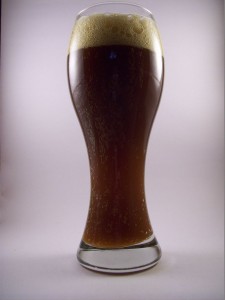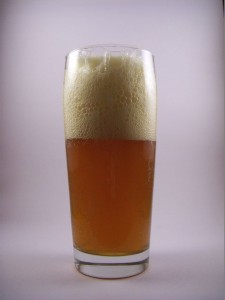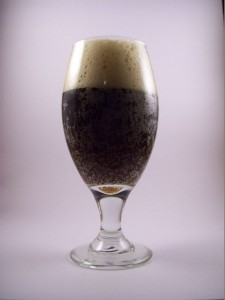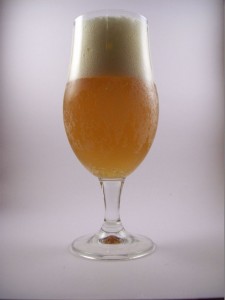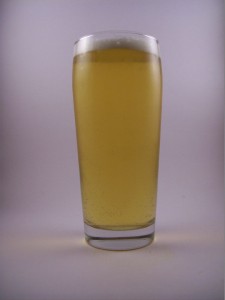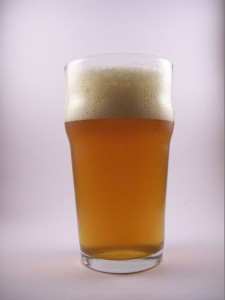Ah, pigfest. That magical time of year when piles of pork and accompanied by gallons of home brew.
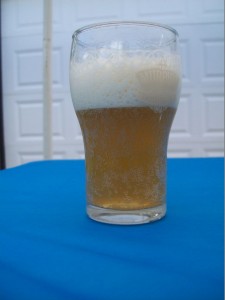
Summer Lite
The first beer was a Munich Helles. It consisted of eight pounds of Pilsner malt with half a pound of Munich and half a pound of melanoiden. An even ounce of Hallertauer at sixty minutes was the only hop addition although the boil do run for ninety. Unlike some of the other lighter brews this one only called for a sixty minute mash. Post-boil the gravity was a slightly high 1.054. For a change of pace we used Wyeast #2308 for the lager fermentation. My overall impression was a clean, grain based flavor with a mild and pleasant fruitiness. I think that’s also a character of the grain since we’ve used Hallertaeur so many times in mild beers. If hops contributed that note it’d be present in more of them. I suppose the yeast is also an option but I don’t normally think of lager yeasts as overly flavorful. Similar to the blonde ale, it’s not mind blowing flavors but a great balance still makes for a tasty beer. It’s light and refreshing but there’s enough flavor to be interesting and enough nuance that it’s not simply sweet. Unlike with the blonde, this time around the sun was shining properly, too, which definitely suits the flavor profile.
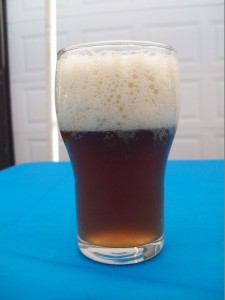
Caramel color & flavor
Next was an American Amber. Despite being an American style the recipe called for an English base malt. We used 7.5# of Maris Otter along with 13 oz Munich, 10 oz Caramel 40, and 6.5 oz each of Victory and Caramel 120. Hops however were definitely not English: 0.75 oz Horizon at the start of the boil, the 0.25 oz each of Cascade and Centennial at 10 minutes and another 0.25 oz each of the C’s at flame out. Gravity was close to target at 1.056 and we fermented with WLP 001. This was the youngest beer of the set (20 days from brewing to tap) and I wonder if it would round out a bit with time. I found the amber extremely sweet. In a vacuum I like the caramel note but here it’s too much. A little funky earthiness comes through from the hops but any citrus or floral flavors get obliterated. More bitterness might bring things in line. It looks nice at least and the flavor isn’t wrong per se just tilted way too far towards malt.
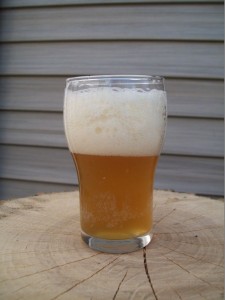
Bohemini
The day’s other lager was a Bohemian Pilsner. The grain bill was an appropriate 9.75# of the namesake malt with 10 oz of Carapils. After that was Saaz, Saaz, and more Saaz. It takes a good bit with such a low alpha. The boil was ninety minutes with 1.50 oz of Saaz and 0.50 oz of Hallertauer at sixty. Therein ends the non-Saaz: we added two more ounces at 30 minutes, then another at 10 minutes, and yet another at flame out. Efficiency was a bit overboard and gravity clocked in at hefty 1.070. I enjoyed tasting this side by side with the Munich Helles because the largely pils-based lagers wound up at very different places. Hops are much more prominent here with a spiciness that changes the entire impression. The sweetness is largely checked but the finish is still crisp. No lingering bitterness follows the initial spice. I prefer the Helles, but I do appreciate having the hops contribute a clear flavor; in so many styles they have a mere complementary role.
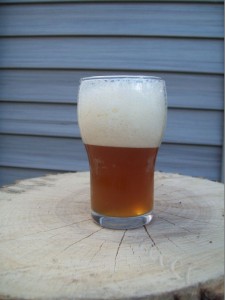
Un-randalized version
Our fourth beer was an American IPA – another hop forward beer with far more alphas in the party. American two row was the backbone (10# 10 oz) along with caramel 20 (13 oz), Munich (10 oz), and caramel 40 (3 oz). The bittering hop was an ounce of Chinook at sixty minutes, and then there were a series of flavor hops bunched towards the tail end: an ounce of Centennial at ten minutes, an ounce of Simcoe at five, and an ounce of Amarillo at flame out. The 1.068 OG was right on style and on target. This was somehow the day’s only representative with WLP001 California Ale yeast. The finished beer is on the more moderate side of hoppy and could probably pass for a pale ale. The balance still definitely leans bitter and is decidedly American but not necessarily bursting with citrus. The Chinook and maybe the Centennial add a earthy flavor and the Simcoe gives a unique pine taste; not that resin/oil feel but heavier than a grassy/floral flavor. Malt takes a backseat but there’s enough for decent body. Serving the beer through a Randalizer of mostly Simcoe brought the hops up another notch and more in line with where I think it should be. Mixing a couple varieties of hops in the output line may have been even better.
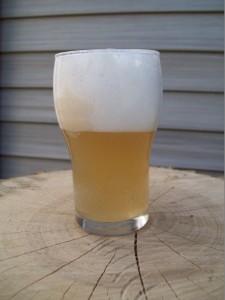
Ich bin ein saeur
Last, and certainly not least, was the Berliner Weisse. This might be the oddest recipe we’ve attempted yet. The grain bill was a tiny six pounds: 3.5# of pilsner and 2.5# of wheat malt. A longer, cooler ninety minute mash fit with the idea of light and clean. Hops were an ounce of Hallertaeur at fifteen minutes – the catch is, that was also at the beginning of the boil. The wort only spent fifteen minutes in the kettle. Despite that we managed to hit a gravity of 1.046 meaning a session ale in most cases but arguably an imperial berliner. We added both European Ale yeast (WLP 011) and Lactobacillus (WLP 677) to the primary fermenter. When we racked into the keg after primary the beer had a seriously salty flavor that made us think something had gone awry. But the finished beer was incredibly light and delicate. I’d be more inclined to call it tart than out and out sour. It’s quite refreshing as it is but having tried a few more berliners since that racking day a little more salinity might be welcome. I think it’s the palest brew we’ve made yet and on-tap carbonation adds to the appearance as well as lightness. For a purposely infected beer I’m surprised that the only flaw is overly mild flavors as opposed to off notes.

